Abstract
Hæger-Aronsen, Birgitta (1971). Brit. J. industr. Med., 28, 52-58. An assessment of the laboratory tests used to monitor the exposure of lead workers. In order to ascertain which laboratory tests are valuable for the monitoring of lead workers, 168 men exposed to lead at eight factories were examined for lead (Pb), protoporphyrin (PP), haemoglobin (Hb), and basophilic stippling of red cells (BSC) in the blood and for δ-aminolevulinic acid (ALA) and coproporphyrin (CP) in the urine.
The counting of BSC and the determination of PP in the blood are both complicated and time-consuming procedures. As they do not offer any particular advantages in the detection or evaluation of lead poisoning they are considered as less suitable.
The concentration of Pb in the blood reflects the absorption of the lead but not its effect. This is certainly a disadvantage.
A highly significant, negative correlation was found between Hb in the blood and ALA in the urine.
The concentrations of ALA and CP in the urine are both good indicators of the degree of lead poisoning. The former is more specific and more sensitive and is therefore considered the most suitable test for the biochemical monitoring of lead workers. A simple, safe, and quick method is recommended.
Determinations of Hb and Pb in the blood may be useful as supplementary methods in the evaluation of lead poisoning but are, in our experience, only seldom needed.
Full text
PDF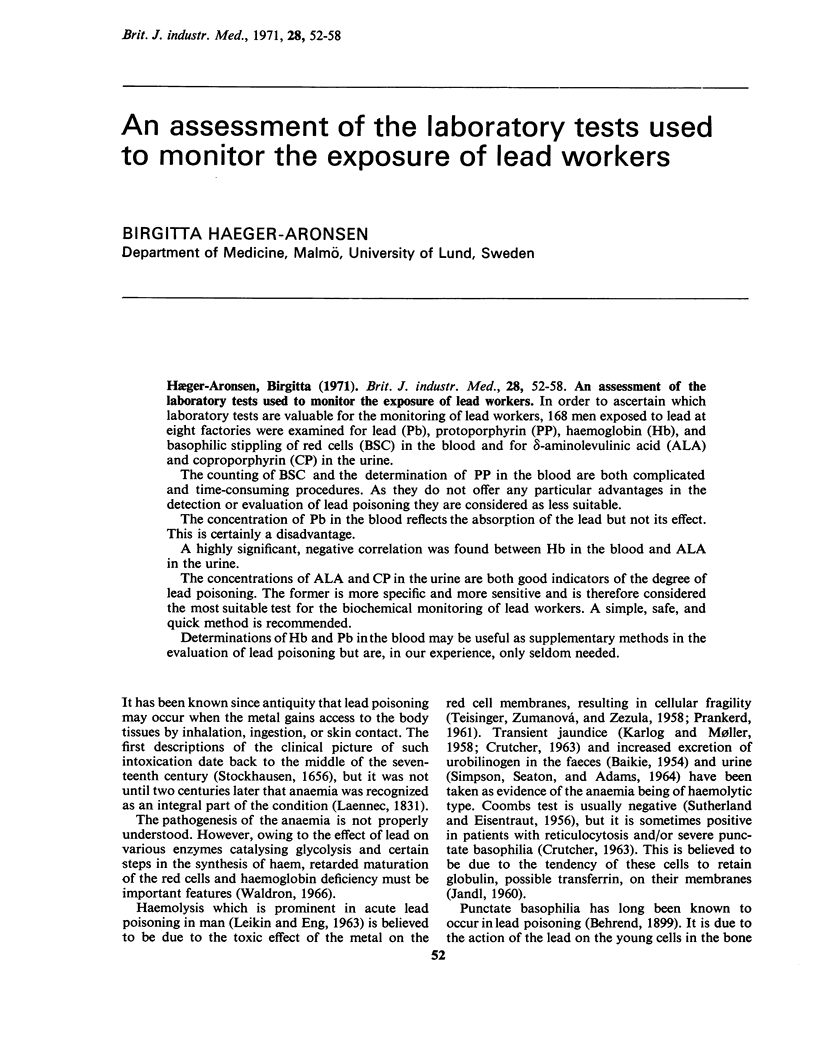
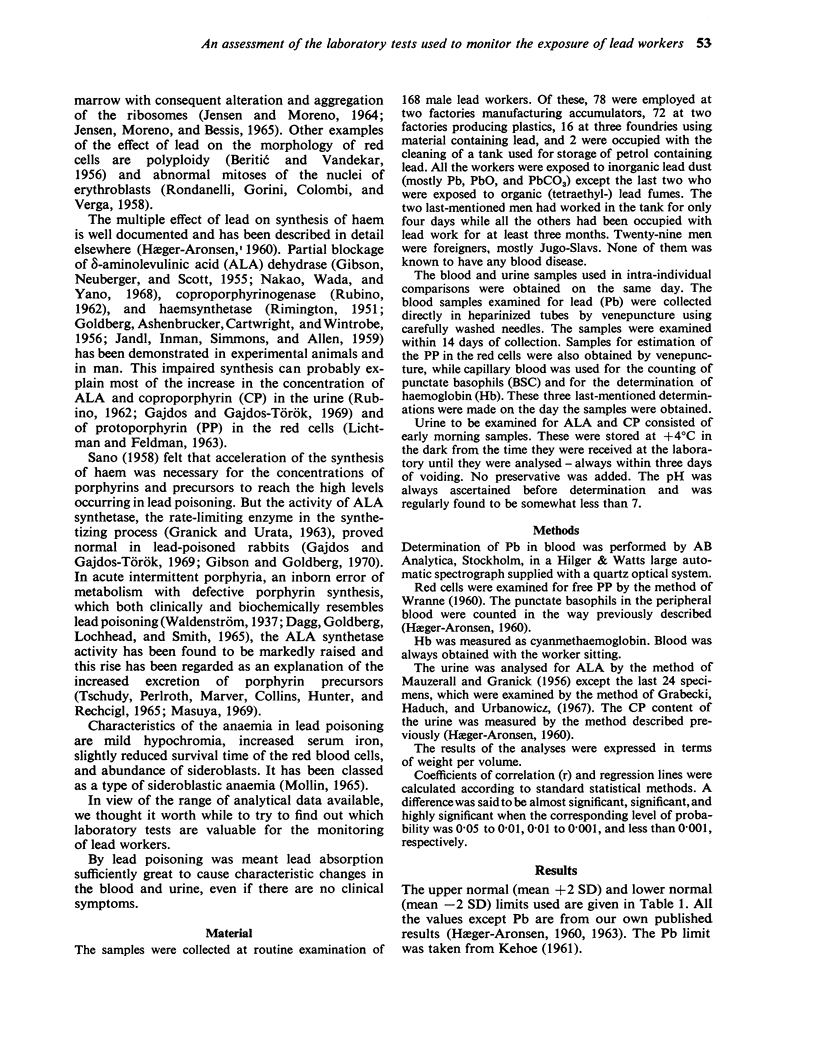
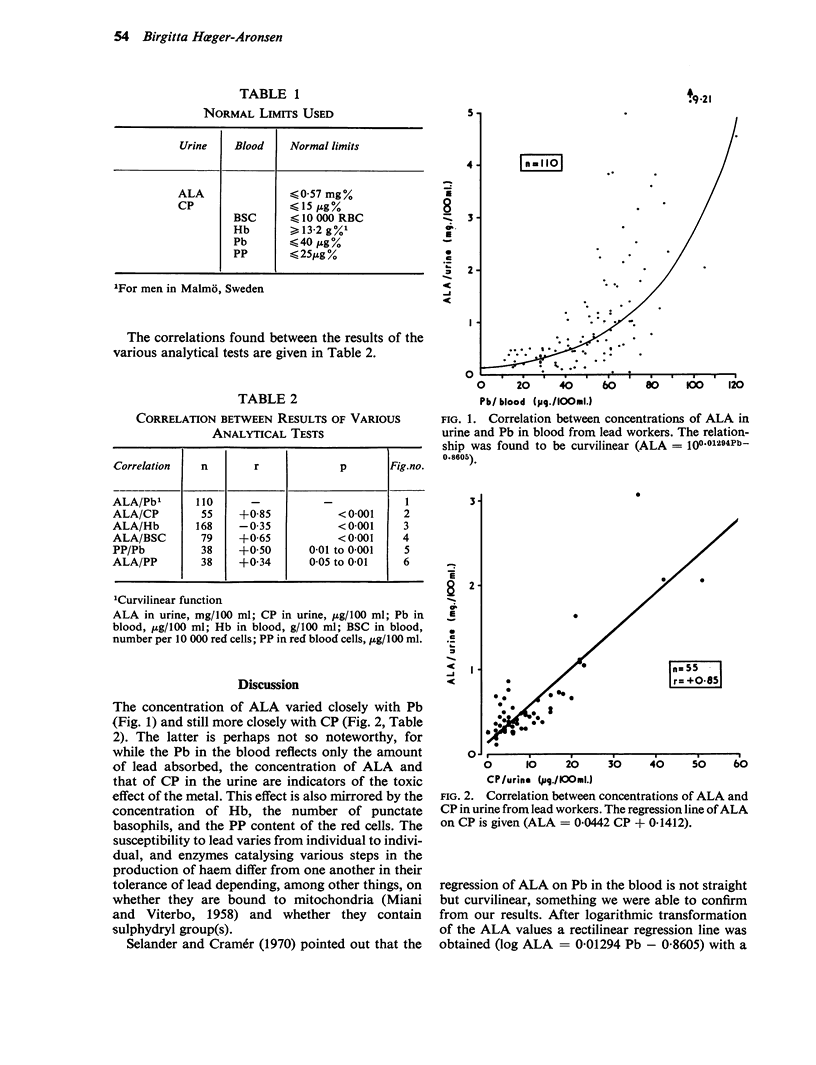
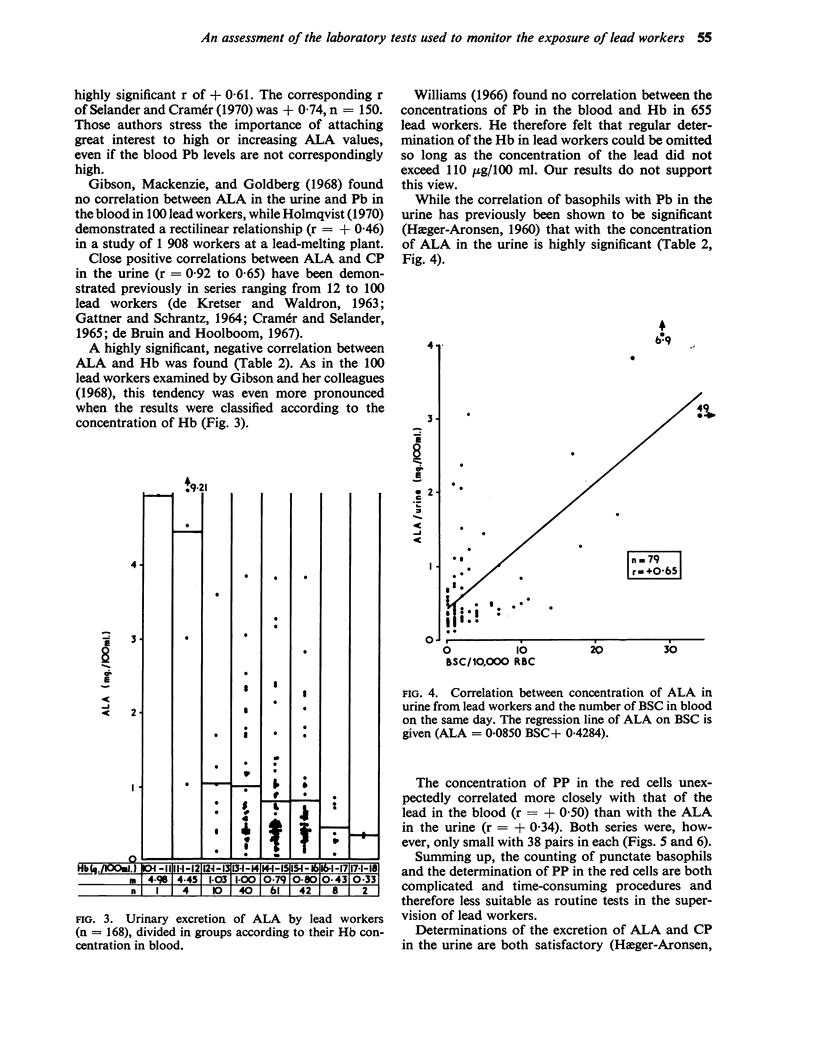
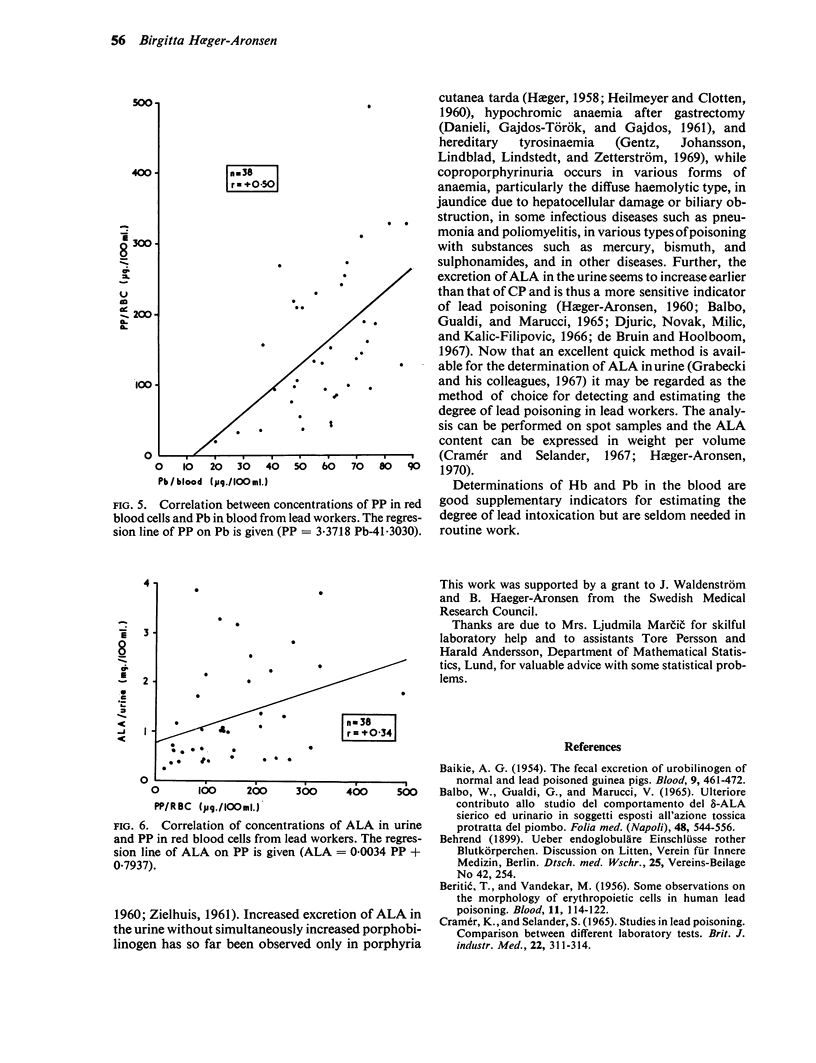
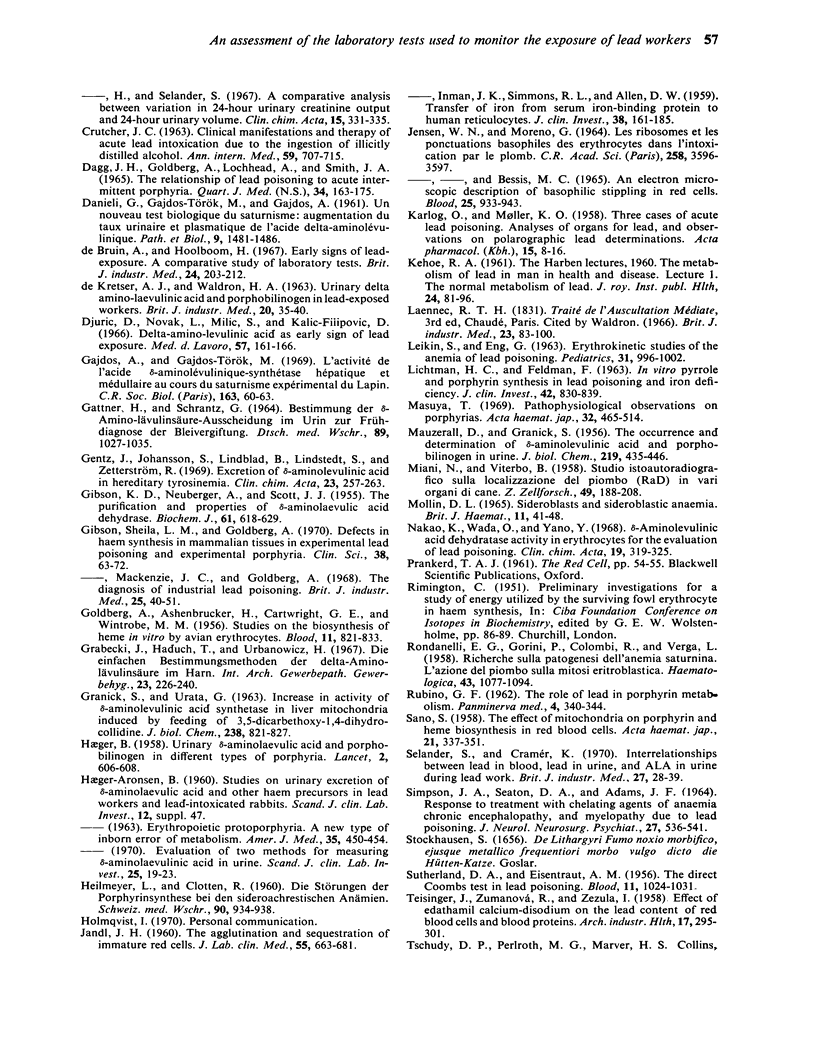
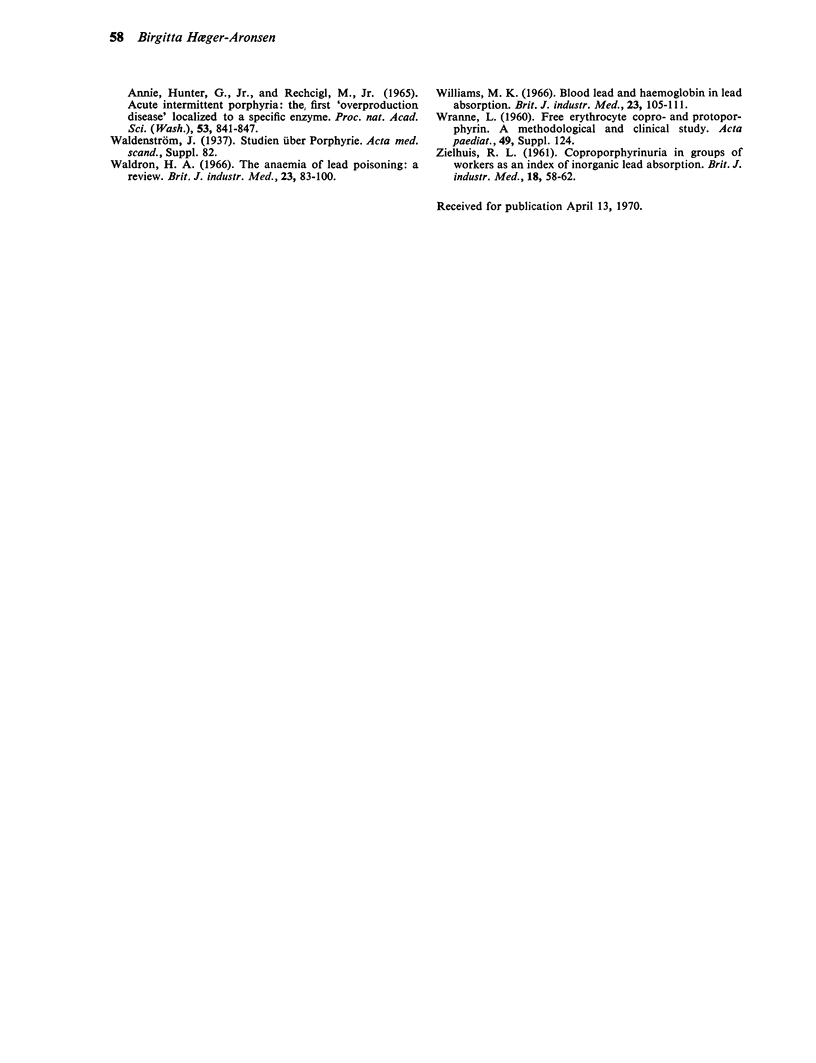
Selected References
These references are in PubMed. This may not be the complete list of references from this article.
- ASHENBRUCKER H., CARTWRIGHT G. E., GOLDBERG A., WINTROBE M. M. Studies on the biosynthesis of heme in vitro by avian erythrocytes. Blood. 1956 Sep;11(9):821–833. [PubMed] [Google Scholar]
- BAIKIE A. G. The fecal excretion of urobilinogen of normal and lead poisoned guinea pigs. Blood. 1954 May;9(5):461–472. [PubMed] [Google Scholar]
- BERITIC T., VANDERKAR M. Some observations on the morphology of erythropoietic cells in human lead poisoning. Blood. 1956 Feb;11(2):114–122. [PubMed] [Google Scholar]
- Balbo W., Gualdi G., Marucci V. Ulteriore contributo allo studio del comportamento del delta-ALA sierico ed urinario in soggetti esposti all'azione tossica protratta del piombo. Folia Med (Napoli) 1965 Jul;48(7):544–556. [PubMed] [Google Scholar]
- CRUTCHER J. C. CLINICAL MANIFESTATIONS AND THERAPY OF ACUTE LEAD INTOXICATION DUE TO THE INGESTION OF ILLICITLY DISTILLED ALCOHOL. Ann Intern Med. 1963 Nov;59:707–715. doi: 10.7326/0003-4819-59-5-707. [DOI] [PubMed] [Google Scholar]
- Cramér K., Selander S. Studies in lead poisoning. Comparison between different laboratory tests. Br J Ind Med. 1965 Oct;22(4):311–314. doi: 10.1136/oem.22.4.311. [DOI] [PMC free article] [PubMed] [Google Scholar]
- DAGG J. H., GOLDBERG A., LOCHHEAD A., SMITH J. A. THE RELATIONSHIP OF LEAD POISONING TO ACUTE INTERMITTENT PORPHYRIA. Q J Med. 1965 Apr;34:163–175. [PubMed] [Google Scholar]
- DE KRETSER A. J., WALDRON H. A. Urinary delta aminolaevulinic acid and porphobilinogen in lead-exposed workers. Br J Ind Med. 1963 Jan;20:35–40. doi: 10.1136/oem.20.1.35. [DOI] [PMC free article] [PubMed] [Google Scholar]
- De Bruin A., Hoolboom H. Early signs of lead-exposure. A comparative study of laboratory tests. Br J Ind Med. 1967 Jul;24(3):203–212. doi: 10.1136/oem.24.3.203. [DOI] [PMC free article] [PubMed] [Google Scholar]
- Djuric D., Novak L., Milic S., Kalic-Filipovic D. Delta-amino-levulinic acid as an early sign of lead exposure. Med Lav. 1966 Mar;57(3):161–166. [PubMed] [Google Scholar]
- EISENTRAUT A. M., SUTHERLAND D. A. The direct Coombs test in lead poisoning. Blood. 1956 Nov;11(11):1024–1031. [PubMed] [Google Scholar]
- GATTNER H., SCHRANTZ G. BESTIMMUNG DER DELTA-AMINOLAEVULINSAEURE-AUSSCHEIDUNG IM URIN ZUR FRUEHDIAGNOSE DER BLEIVERGIFTUNG. Dtsch Med Wochenschr. 1964 May 22;89:1027–1035. doi: 10.1055/s-0028-1111253. [DOI] [PubMed] [Google Scholar]
- GIBSON K. D., NEUBERGER A., SCOTT J. J. The purification and properties of delta-aminolaevulic acid dehydrase. Biochem J. 1955 Dec;61(4):618–629. doi: 10.1042/bj0610618. [DOI] [PMC free article] [PubMed] [Google Scholar]
- GRANICK S., URATA G. Increase in activity of alpha-aminolevulinic acid synthetase in liver mitochondria induced by feeding of 3,5-dicarbethoxy-1,4-dihydrocollidine. J Biol Chem. 1963 Feb;238:821–827. [PubMed] [Google Scholar]
- Gajdos A., Gajdos-Török M. L'activité de l'acide delta-aminolévulinique-synthétase hépatique et médullaire au cours du saturnisme expérimental du lapin. C R Seances Soc Biol Fil. 1969;163(1):60–63. [PubMed] [Google Scholar]
- Gentz J., Johansson S., Lindblad B., Lindstedt S., Zetterström R. Exertion of delta-aminolevulinic acid in hereditary tyrosinemia. Clin Chim Acta. 1969 Feb;23(2):257–263. doi: 10.1016/0009-8981(69)90040-0. [DOI] [PubMed] [Google Scholar]
- Gibson S. L., Goldberg A. Defects in haem synthesis in mammalian tissues in experimental lead poisoning and experimental porphyria. Clin Sci. 1970 Jan;38(1):63–72. doi: 10.1042/cs0380063. [DOI] [PubMed] [Google Scholar]
- Gibson S. L., Mackenzie J. C., Goldberg A. The diagnosis of industrial lead poisoning. Br J Ind Med. 1968 Jan;25(1):40–51. doi: 10.1136/oem.25.1.40. [DOI] [PMC free article] [PubMed] [Google Scholar]
- Grabecki J., Haduch T., Urbanowicz H. Die einfachen Bestimmungsmethoden der delta-Aminolävulinsäure im Harn. Int Arch Arbeitsmed. 1967;23(3):226–240. [PubMed] [Google Scholar]
- HAEGER B. Urinary delta-aminolaevulic acid and porphobilinogen in different types of porphyria. Lancet. 1958 Sep 20;2(7047):606–608. doi: 10.1016/s0140-6736(58)90334-9. [DOI] [PubMed] [Google Scholar]
- HEILMEYER L., CLOTTEN R. [Disorders of porphyrin synthesis in sideroachrestic anemias]. Schweiz Med Wochenschr. 1960 Aug 20;90:934–938. [PubMed] [Google Scholar]
- JANDL J. H., INMAN J. K., SIMMONS R. L., ALLEN D. W. Transfer of iron from serum iron-binding protein to human reticulocytes. J Clin Invest. 1959 Jan 1;38(1 Pt 1):161–185. doi: 10.1172/JCI103786. [DOI] [PMC free article] [PubMed] [Google Scholar]
- JANDL J. H. The agglutination and sequestration of immature red cells. J Lab Clin Med. 1960 May;55:663–681. [PubMed] [Google Scholar]
- JENSEN W. N., MORENO G. D., BESSIS M. C. AN ELECTRON MICROSCOPIC DESCRIPTION OF BASOPHILIC STIPPLING IN RED CELLS. Blood. 1965 Jun;25:933–943. [PubMed] [Google Scholar]
- JENSEN W. N., MORENO G. LES RIBOSOMES ET LES PONCTUATIONS BASOPHULES DES ERYTHROCYTES DANS L'INTOXICATION PAR LE PLOMB. C R Hebd Seances Acad Sci. 1964 Apr 1;258:3596–3597. [PubMed] [Google Scholar]
- KARLOG O., MOLLER K. O. Three cases of acute lead poisoning: analyses of organs for lead, and observations on polarographic lead determinations. Acta Pharmacol Toxicol (Copenh) 1958;15(1):8–16. doi: 10.1111/j.1600-0773.1958.tb00280.x. [DOI] [PubMed] [Google Scholar]
- LEIKIN S., ENG G. Erythrokinetic studies of the anemia of lead poisoning. Pediatrics. 1963 Jun;31:996–1002. [PubMed] [Google Scholar]
- LICHTMAN H. C., FELDMAN F. In vitro pyrrole and porphyrin synthesis in lead poisoning and iron deficiency. J Clin Invest. 1963 Jun;42:830–839. doi: 10.1172/JCI104775. [DOI] [PMC free article] [PubMed] [Google Scholar]
- MAUZERALL D., GRANICK S. The occurrence and determination of delta-amino-levulinic acid and porphobilinogen in urine. J Biol Chem. 1956 Mar;219(1):435–446. [PubMed] [Google Scholar]
- MIANI N., VITERBO B. Studio istoautoradiografico sulla localizzazione del piombo (RaD) in vari organl di cane. Z Zellforsch Mikrosk Anat. 1958;49(2):188–208. [PubMed] [Google Scholar]
- MOLLIN D. L. SIDEROBLASTS AND SIDEROBLASTIC ANAEMIA. Br J Haematol. 1965 Jan;11:41–48. doi: 10.1111/j.1365-2141.1965.tb00082.x. [DOI] [PubMed] [Google Scholar]
- Nakao K., Wada O., Yano Y. Delta-aminolevulinic acid dehydratase activity in erythrocytes for the evaluation of lead poisoning. Clin Chim Acta. 1968 Feb;19(2):319–325. doi: 10.1016/0009-8981(68)90341-0. [DOI] [PubMed] [Google Scholar]
- RUBINO G. F. The role of lead in porphyrin metabolism. Panminerva Med. 1962 Jul-Aug;4:340–344. [PubMed] [Google Scholar]
- SIMPSON J. A., SEATON D. A., ADAMS J. F. RESPONSE TO TREATMENT WITH CHELATING AGENTS OF ANAEMIA, CHRONIC ENCEPHALOPATHY, AND MYELOPATHY DUE TO LEAD POISONING. J Neurol Neurosurg Psychiatry. 1964 Dec;27:536–541. doi: 10.1136/jnnp.27.6.536. [DOI] [PMC free article] [PubMed] [Google Scholar]
- Selander S., Cramér K. Interrelationships between lead in blood, lead in urine, and ALA in urine during lead work. Br J Ind Med. 1970 Jan;27(1):28–39. doi: 10.1136/oem.27.1.28. [DOI] [PMC free article] [PubMed] [Google Scholar]
- TEISINGER J., ZUMANOVA R., ZEZULA I. Effect of edathamil calcium-disodium on the lead content of red blood cells and blood proteins. AMA Arch Ind Health. 1958 Apr;17(4):295–301. [PubMed] [Google Scholar]
- TSCHUDY D. P., PERLROTH M. G., MARVER H. S., COLLINS A., HUNTER G., Jr, RECHCIGL M., Jr ACUTE INTERMITTENT PORPHYRIA: THE FIRST "OVERPRODUCTION DISEASE" LOCALIZED TO A SPECIFIC ENZYME. Proc Natl Acad Sci U S A. 1965 Apr;53:841–847. doi: 10.1073/pnas.53.4.841. [DOI] [PMC free article] [PubMed] [Google Scholar]
- Waldron H. A. The anaemia of lead poisoning: a review. Br J Ind Med. 1966 Apr;23(2):83–100. doi: 10.1136/oem.23.2.83. [DOI] [PMC free article] [PubMed] [Google Scholar]
- Waldron H. A. The anaemia of lead poisoning: a review. Br J Ind Med. 1966 Apr;23(2):83–100. doi: 10.1136/oem.23.2.83. [DOI] [PMC free article] [PubMed] [Google Scholar]
- Williams M. K. Blood lead and haemoglobin in lead absorption. Br J Ind Med. 1966 Apr;23(2):105–111. doi: 10.1136/oem.23.2.105. [DOI] [PMC free article] [PubMed] [Google Scholar]
- ZIELHUIS R. L. Coproporphyrinuria in groups of workers as an index of inorganic lead absorption. Br J Ind Med. 1961 Jan;18:58–62. doi: 10.1136/oem.18.1.58. [DOI] [PMC free article] [PubMed] [Google Scholar]


